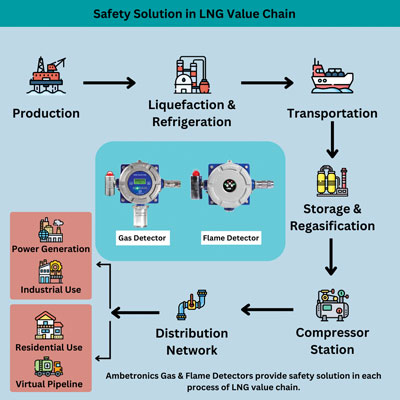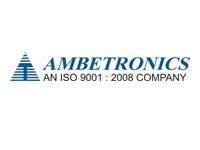With growth in the use of Natural Gas, the need for economic and efficient ways for its transportation has also increased. Liquefied form being much denser than the gaseous form, it is way more efficient to transport. There are various distinct processes to make LNG involving refrigeration of gas, then expanding it to turn the liquefied gas into a cryogenic liquid. There is a risk of toxic or flammable gas leaks at almost every step and it requires protection by a gas and flame detection system.
LNG is non-flammable as a cryogenic liquid, but as it warms and vaporizes back into gas, it becomes more volatile. Natural gas consists of methane which at concentration level of 5 to 15% can form a flammable composition and it makes a cloud of methane gas if LNG leaks into the environment. There are some non-flammable hazards as well in LNG facilities, such as the presence of refrigerants and other chemicals used in the gas treatment process.
The LNG Value Chain, explains the various processes and its hazards at every stage due to gas leak.

Production:
Natural gas is extracted from ground reservoirs and transported through pipelines. Natural Gas includes gases such as ethane, propane, pentanes, hydrogen sulphide, carbon dioxide, helium and nitrogen. At the initial stage of gas processing, most of the impurities and water is removed before the gas is sent for further treatment. Due to presence of different combustible gases at this stage, suitable gas detection and monitoring system becomes very important.
Liquefaction:
Treated natural gas is transported through pipelines to the liquefaction plant, where feed gas processing removes the particulate and other acid impurities such as mercury, hydrogen sulphide (H2S) and carbon dioxide (CO2). We should install gas detectors and IR detectors in those areas to prevent against hazards of gas leaks.
Refrigeration:
At refrigeration process, treated natural gas is converted to the liquid form. LNG mainly contains methane, with small amounts of ethane, propane and butane. To get maximum reduction of gas volume, it is converted to liquid form by chilling it at about -162o Celsius for being transported. Due to abundantly changing operating conditions, thermal expansion of liquefaction installations including compressor, pump or hydraulic turbine, there is high risk of gas leakage.
Transportation:
LNG is pumped from storage tanks to containers using cryogenic pumps. At this stage, hoses and loading arms are used to boost the gases. The gas leak may occur at this stage and to monitor gas leak, we have to deploy a reliable gas & flame detection system.

Storage & Regasification:
During storage of LNG after unloading, it is sent for regasification process where it is heated and expanded again to the original gaseous state. Then it is ready to be delivered into the natural gas pipeline. Here distinctive odour can be added to gas which helps to sense gas leakage. It is important that unloading and storage tanks are closely monitored for gas leakage through flame and gas detection system.
Compressor Station:
After regasification process, there is important task at compressor station. Here, large volume of gas is transported from LNG terminal to gas transmission network. Compressor station is placed around the transportation pipeline network to maintain the pressure and flow of gas to the consumer. Entire network needs proper functioning and risk mitigation, so advance technology of flame and gas detector & monitoring system needs to be installed.
Distribution Network:
Distribution of the LNG to consumer is generally done through transmission pipeline for delivery to residential consumers, industrial users and power generation plants etc. In distribution network and consumer usage, chances of leakage is very high and risk can be mitigated through advance gas leak detection and monitoring system.
Safety Solution in LNG Value Chain
In each facility of LNG value chain, reliable flame and gas detection technology is required which provides human & industrial safety. Ambetronics offers range of safety instruments which can provide solution at each stage in operation of LNG value chain facility.
Ambetronics safety instrument has an exceptionally effective alarming system which alerts the workers and personnel whenever the concentration of leak goes beyond the permissible limit.
Gas Detectors by Ambetronics are configured with gas monitors whose relay output operates the exhaust fans automatically.


